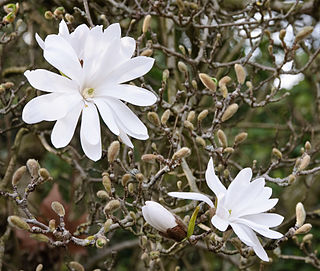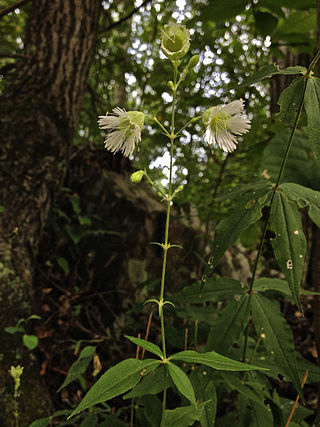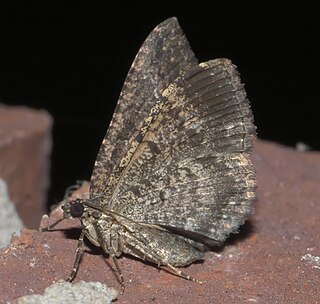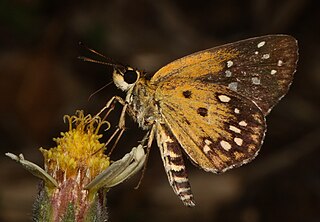
Gymnophthalmidae is a family of lizards with at least 250 species, sometimes known commonly as spectacled lizards or microteiids. They are called "spectacled" because of their transparent lower eyelids, which allow them to still see with closed eyes. As in most lizards, except geckos, these eyelids are movable. The Alopoglossidae have been recently moved from this family.
Riolama is a small genus of lizards in the family Gymnophthalmidae.

Magnolia stellata, the star magnolia, is a slow-growing deciduous shrub or small tree native to Japan. It bears large, showy white or pink flowers in early spring, before its leaves open. This species is closely related to the Kobushi magnolia, and is treated by many botanists as a variety or even a cultivar of that. However, Magnolia stellata was accepted as a distinct species in the 1998 monograph by Hunt.

Quercus stellata, the post oak or iron oak, is a North American species of oak in the white oak section. It is a slow-growing oak that lives in dry areas on the edges of fields, tops of ridges, and also grows in poor soils, and is resistant to rot, fire, and drought. Interbreeding occurs among white oaks, thus many hybrid species combinations occur. It is identifiable by the rounded cross-like shape formed by the leaf lobes and hairy underside of the leaves.

Green Mansions: A Romance of the Tropical Forest (1904) is an exotic romance by William Henry Hudson about a traveller to the Guyana jungle of southeastern Venezuela and his encounter with a forest-dwelling girl named Rima.

Erica tetralix, the cross-leaved heath, is a species of flowering plant in the family Ericaceae, native to western Europe.

"Le cygne", pronounced[ləsiɲ], or "The Swan", is the 13th and penultimate movement of The Carnival of the Animals by Camille Saint-Saëns. Originally scored for solo cello accompanied by two pianos, it has been arranged and transcribed for many instruments but remains best known as a cello solo.

Hohenbergia stellata is a perennial species of the genus Hohenbergia. It is native to Trinidad and Tobago, Martinique, Netherlands Antilles, Venezuela, and northeastern Brazil.

Nymphaea nouchali, often known by its synonym Nymphaea stellata, or by common names blue lotus, star lotus, red water lily, dwarf aquarium lily, blue water lily, blue star water lily or manel flower, is a water lily of genus Nymphaea. It is native to southern and eastern parts of Asia, and is the national flower of Bangladesh and Sri Lanka. In Sanskrit it is called utpala. This species is usually considered to include the blue Egyptian lotus N. nouchali var. caerulea. In the past, taxonomic confusion has occurred, with the name Nymphaea nouchali incorrectly applied to Nymphaea pubescens.

Silene stellata, known by the common names starry campion, widow's frill, and whorled catchfly, is a perennial herbaceous summer forb with white flowers, native to the central and eastern United States. It grows in habitats such as forests, river flats, and tall grass prairies.

Disclisioprocta stellata, the somber carpet or bougainvillea looper, is a moth of the family Geometridae. It is found in sub-Saharan Africa, the islands of the Indian Ocean, and from eastern Canada south through the United States, Mexico, the Antilles, Bahamas and Bermuda Islands to Bolivia and Brazil. It was introduced to Hawaii in 1993.
Marivagia is a monotypic genus of jellyfish, containing only the species, Marivagia stellata, that was first described in 2010 following the discovery of several specimens on the Mediterranean coast of Israel.

Dotta stellata, the spangled sylph or spangled skipper, is a species of butterfly in the family Hesperiidae. It is found in Kenya, Tanzania, Malawi, Zambia, Mozambique and Zimbabwe. The habitat consists of forests.

Collix stellata is a moth in the family Geometridae first described by William Warren in 1894. It is found in Korea, Japan, Taiwan and northern India.
Riolama inopinata is a species of lizard in the family Gymnophthalmidae. It is endemic to Venezuela.
Riolama leucosticta, the white-spotted riolama, is a species of lizard in the family Gymnophthalmidae. It is endemic to Venezuela.
Riolama luridiventris is a species of lizard in the family Gymnophthalmidae. It is endemic to Venezuela.
Riolama uzzelli is a species of lizard in the family Gymnophthalmidae. The species is endemic to Venezuela.
Riolama grandis is a species of lizard in the family Gymnophthalmidae. It is endemic to Brazil.

Berthella stellata is a species of sea slug in the family Pleurobranchidae. It is found in shallow water in the Mediterranean Sea, the western Atlantic Ocean and the tropical and subtropical Indo-Pacific region.












